Chapter 3: Approaches to budgets
Chapter learning objectives
Upon completion of this chapter you will be able to:
- evaluate the strengths and weaknesses of alternative budgeting models and compare such techniques as fixed and flexible, rolling, activity based, zero based and incremental
- assess how budgeting may differ in not-for-profit organisations from profit-seeking organisations
- evaluate the impact to an organisation of a move to 'beyond budgeting'.
1 Exam focus
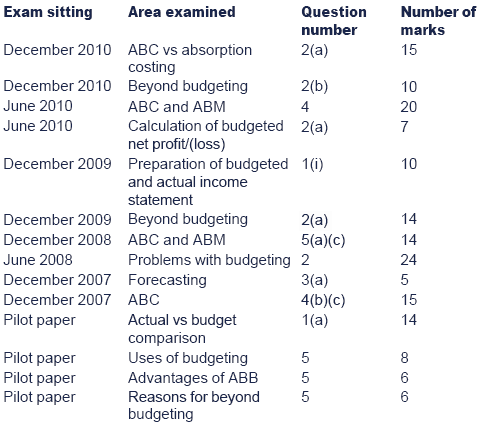
2 Introduction
 A budgetis a quantitative plan prepared for a specific time period. It isnormally expressed in financial terms and prepared for one year.
A budgetis a quantitative plan prepared for a specific time period. It isnormally expressed in financial terms and prepared for one year.
Budgeting serves a number of purposes:
- Planning
- Control
- Communication
- Co-ordination
- Evaluation
- Motivation
- Authorisation
- Delegation

 Purposes of budgeting
Purposes of budgeting
Budgeting serves a number of purposes:
Planning
A budgeting process forces the business to look into the future.This is essential for survival since it stops management from relying onad hoc or poorly co-ordinated planning.
Control
Actual results are compared against the budget and action is taken as appropriate.
Communication
The budget is a formal communication channel that allows junior and senior staff to converse.
Co-ordination
The budget allows co-ordination of all parts of the business towards a common corporate goal.
Evaluation
Responsibility accounting divides the organisation into budgetcentres, each of which has a manager who is responsible for itsperformance. The budget may be used to evaluate the actions of a managerwithin the business in terms of costs and revenues over which they havecontrol.
Motivation
The budget may be used as a target for managers to aim for. Rewardsshould be given for operating within or under budgeted levels ofexpenditure. This acts as a motivator for managers.
Authorisation
The budget acts as a formal method of authorisation for a managerfor expenditure, hiring staff and the pursuit of plans contained withinthe budget.
Delegation
Managers may be involved in setting the budget. Extraresponsibility may motivate managers. Management involvement may alsoresult in more realistic targets.

3 Methods of budgeting
Different approaches to budgeting have been studied in paper F5.Section 3 of this chapter is thus primarily a recap of 'deemed'knowledge.
3.1 Fixed and flexible budgeting
A fixed budget is a budget prepared at a single level of activity.
A flexible budget is a budget prepared with the costbehaviour of all cost elements known and classified as either fixed orvariable. The budget may be prepared at a number of activity levels andcan be 'flexed' or changed to the actual level of activity for budgetarycontrol purposes.

 Test your understanding 1
Test your understanding 1
A company has the following budgeted and actual information for a department.

(a)Assuming all costs are variable, has the company done better or worse than expected?
(b)If $10,000 of the budgeted costs are fixedcosts, the remainder being variable, has the company performed better orworse than expected?



 Test your understanding 2
Test your understanding 2
Redfern hospital is a government funded hospital in the country ofNewland. Relevant cost data for the year ended 31 December 20X0 are asfollows:
(1)Salary costs per staff member were payable as follows:

Budgeted and actual staff were 60 doctors and 150 nurses.
(2)Budgeted costs for the year based on 20,000 patients per annum were as follows:

Variable costs vary according to the number of patients.
(3)The actual number of patients for the yearwas 23,750. Actual costs (excluding the cost of doctors and nurses)incurred during the year were as follows:

Required:
Prepare a statement which shows the actual andbudgeted costs for Redfern hospital in respect of the year ended 31December 20X0 on a comparable basis.

3.2 Incremental budgets
 An incremental budgetstarts with the previous period's budget or actual results, and adds(or subtracts) an incremental amount to cover inflation and other knownchanges.
An incremental budgetstarts with the previous period's budget or actual results, and adds(or subtracts) an incremental amount to cover inflation and other knownchanges.
Suitability
- It is suitable for stable businesses, where costs are not expected to change significantly.
- There should be good cost control.
- There should be limited discretionary costs.


 Incremental approach to budgets
Incremental approach to budgets
AW plc produces two products, A and C. In the last year (20X4) itproduced 640 units of A and 350 units of C incurring costs of $672,000.Analysis of the costs has shown that 75% of the total costs arevariable. 60% of these variable costs vary in line with the number of Aproduced and the remainder with the number of C.
The budget for the year 20X5 is now being prepared using anincremental budgeting approach. The following additional information isavailable for 20X5:
- All costs will be 4% higher than the average paid in 20X4.
- Efficiency levels will remain unchanged.
- Expected output of A is 750 units and of C is 340 units.
Required:
What is the budgeted total variable cost of product C (to the nearest $100) for the full year 20X5?
Solution:
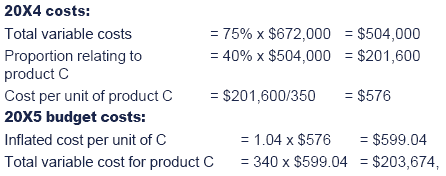
i.e. $203,700 to nearest $100.


 Test your understanding 3
Test your understanding 3
The NW Entertainments Company (NWEC) is a privately ownedorganisation which operates an amusement park in a rural area within theNorth West region of a country which has a good climate all year round.The amusement park comprises a large fairground with high-quality ridesand numerous attractions designed to appeal to people of all ages.
The park is open for 365 days in the year.
Each day spent by a guest at the park is classed as a 'VisitorDay'. During the year ended 30 November 20X3 a total of 2,090,400visitor days were paid for and were made up as follows:

Two types of admission pass are available for purchase, these are:
The 'One-day Visitor's pass' and the 'Two-day Visitor's pass',which entitles the holder of the pass to admission to the amusement parkon any two days within the year commencing 1 December.
The pricing structure was as follows:
(i)The cost of a One-day pass for anadult was $40. Visitors aged 14–18 years and Senior Citizens receive a25% discount against the cost of adult passes. Visitors aged below 14years receive a 50% discount against the cost of adult passes.
(ii) The purchase of a Two-day Visitor's pass gave the purchaser a 25% saving against the cost of two One-day Visitor's passes.
(iii)25% of the total visitor days werepaid for by the purchase of One-day passes. The remainder were paid forby the purchase of Two-day passes.
Total operating costs of the park during the year amounted to $37,600,000.
NWEC receives income from traders who provide catering and otherfacilities to visitors to the amusement park. There are 30 such tradersfrom whom payments are received. The amount of the payment made by eachtrader is dependent upon the size of the premises that they occupy inthe amusement park as shown in the following summary:

The income from each trader is received under 3 year contractswhich became effective on 1 December 20X3. The income is fixed for theduration of each contract.
All operating costs of the park incurred during the year ending 30November 20X4 are expected to increase by 4%. This has led to a decisionby management to increase the selling price of all categories ofadmission passes by 4% with effect from 1 December 20X3. Managementexpect the number of visitor days, visitor mix and the mix of admissionpasses purchased to be the same as in the previous year.
NWEC also own a 400 bedroom hotel with leisure facilities, which is located 20 kilometres from the amusement park.
During the year ended 30 November 20X3, the charge per room on anall-inclusive basis was $100 per room, per night. The total operatingcosts of the hotel amounted to $7,950,000. Average occupancy during theyear was 240 rooms per night. The hotel is open for 365 days in theyear.
It is anticipated that the operating costs of the hotel willincrease by 4% in the year ending 30 November 20X4. Management havedecided to increase the charge per room, per night by 4% with effectfrom 1 December 20X3 and expect average occupancy will remain at thesame level during the year ending 30 November 20X4.
The revenue of the hotel is independent of the number of visitors to the amusement park.
Prepare a statement showing the budgeted net profit or loss for the year to 30 November 20X4

3.3 Zero based budgets
 Zero based budgeting(ZBB) is a method of budgeting that requires each cost element to bespecifically justified, as though the activities to which the budgetrelates were being undertaken for the first time. Without approval, thebudget allowance is zero.
Zero based budgeting(ZBB) is a method of budgeting that requires each cost element to bespecifically justified, as though the activities to which the budgetrelates were being undertaken for the first time. Without approval, thebudget allowance is zero.
Suitability
- Fast moving businesses/industries
- Discretionary costs such as research and development (R&D).
- Public sector organisations such as local authorities.
ZBB process
There are four distinct staged in the implementation of ZBB:
(1)Managers should specify for their responsibility centres those activities that can be individually evaluated.
(2)Each of the individual activities is thendescribed in a decision package. The decision package should state thecosts and revenues expected from the given activity. It should be drawnup in such a way that the package can be evaluated and ranked againstother packages.
(3)Each decision package is evaluated and ranked usually using cost/benefit analysis.
(4)The resources are then allocated to the various packages.

 ZBB
ZBB
A decision package was defined by Peter Pyhrr (who first formulated the ZBB approach at Texas Instruments) as:
'A document that identifies and describes a specific activity in such a manner that senior management can:
A evaluate it and rank it against other activities competing for limited resources and
B decide whether to approve or disapprove it.'
A decision package is a document that does the following:
- Analyses the cost of the activity. (Costs may be built up from a zero base, but costing information can be obtained from historical records or last year's budget.)
- States the purpose of the activity.
- Identifies alternative methods of achieving the same purpose.
- Assesses the consequence of not doing the activity at all, or performing the activity at a different level.
- Establishes measures of performance for the activity.
Pyhrr identifies two types of package:
iMutually-exclusive packages. These contain different methods of obtaining the same objective.
ii Incremental packages. These dividethe activity into a number of different levels of activity. The basepackage describes the minimum effort and cost that is needed to carryout the activity. The other packages describe the incremental costs andbenefits when added to the base.


 ZBB exercise
ZBB exercise
A company is conducting a ZBB exercise, and a decision package is being prepared for its materials-handling operations.
- The manager responsible has identified a base package for the minimum resources needed to perform the materials-handling function. This is to have a team of five workers and a supervisor, operating without any labour-saving machinery. The estimated annual cost of wages and salaries, with overtime, would be $375,000.
- In addition to the base package, the manager has identified an incremental package. The company could lease two forklift trucks at a cost of $20,000 each year. This would provide a better system because materials could be stacked higher and moved more quickly. Health and safety risks for the workers would be reduced, and there would be savings of $5,000 each year in overtime payments.
- Another incremental package has been prepared, in which the company introduces new computer software to plan materials-handling schedules. The cost of buying and implementing the system would be $60,000, but the benefits are expected to be improvements in efficiency that reduce production downtime and result in savings of $10,000 each year in overtime payments.
The base package would be considered essential, and so given a highpriority. The two incremental packages should be evaluated and ranked.Here, the forklift trucks option might be ranked more highly than thecomputer software.
In the budget that is eventually decided by senior management, theforklift truck package might be approved, but the computer softwarepackage rejected on the grounds that there are other demands forresources with a higher priority.


 Test your understanding 4
Test your understanding 4
For a number of years, the research division of Z plc has producedits annual budget (for new and continuing projects) using incrementalbudgeting techniques. The company is now under new management and theannual budget for 20X4 is to be prepared using ZBB techniques.
Explain how Z plc could operate a ZBB system for its research projects.

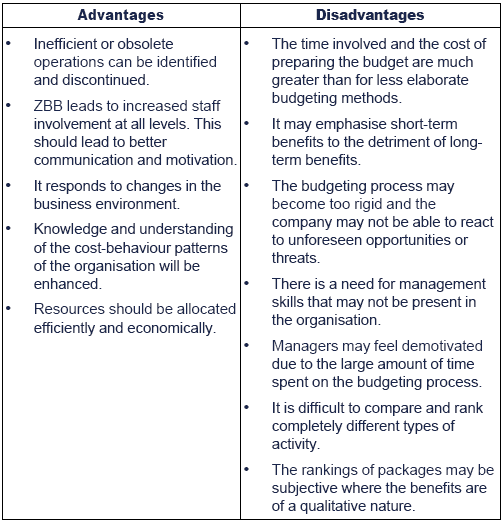
Question focus: Now attempt question 4 from chapter 13.
3.4 Rolling budgets
 A rolling budgetis one that is kept continuously up to date by adding anotheraccounting period (e.g. month or quarter) when the earliest accountingperiod has expired.
A rolling budgetis one that is kept continuously up to date by adding anotheraccounting period (e.g. month or quarter) when the earliest accountingperiod has expired.
Suitability
- Accurate forecasts cannot be made.
- For any area of business that needs tight control.


 Test your understanding 5
Test your understanding 5
A company uses rolling budgeting and has a sales budget as follows:

Actual sales for Quarter 1 were $123,450. The adverse variance isfully explained by competition being more intense than expected andgrowth being lower than anticipated. The budget committee has proposedthat the revised assumption for sales growth should be 3% per quarterfor Quarters 2, 3 and 4.
Update the budget figures for Quarters 2-4 as appropriate.

3.5 Activity-based budgeting (ABB)
Before we look at activity-based budgeting, it is useful to review the activity based models in general.
3.5.1 Activity-based costing (ABC)
Aim: the aim of ABC is to calculate the full production costper unit. It is an alternative to absorption costing in a modernbusiness environment.

 Reasons for the development of ABC
Reasons for the development of ABC
- Absorption costing is based on the principle that production overheads are driven by the level of production. This was true in the past when businesses tended to produce only one product or a few simple and similar products. However, higher levels of competition has resulted in the diversity and complexity of the products increasing. As a result, there are a number of different factors that drive overheads, not simply the level of production.
- Production overheads are a larger proportion of total costs in modern manufacturing since manufacturing has become more machine intensive and less labour intensive. Therefore, it is important that an accurate estimate is made of the production overhead per unit.

Steps in ABC
Step 1: Group production overheads into activities (cost pools), according to how they are driven.
Step 2: Identify cost drivers for each activity, i.e. what causes the activity costs to be incurred.
Step 3: Calculate an overhead absorption rate (OAR) for each activity.
Step 4: Absorb the activity costs into the product.
Step 5: Calculate the full production cost and/or the profit or loss.
The TYU below recaps the calculation of the full production costper unit using traditional absorption costing and using ABC. Ensure youunderstand the calculation and that you can comment on the reasons forthe differences between the full production cost per unit under the twocosting methods.

 Test your understanding 6
Test your understanding 6
Trimake Ltd makes three main products, using broadly the sameproduction methods and equipment for each. A conventional absorptioncosting system is used at present, although an activity based costing(ABC) system is being considered. Details of the three products for atypical period are:

Direct labour costs $6 per hour and production overheads areabsorbed on a machine hour basis. The rate for the period is $28 permachine hour (i.e. the OAR) and a total of 23,375 machine hours wereworked.
Traditional absorption costing would give a full production cost per unit as follows:
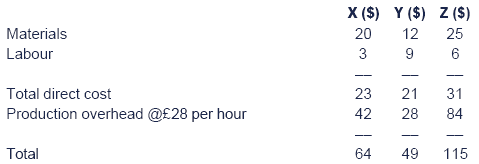
Further analysis shows the total production overhead of $654,500 isnot entirely driven by machine hours and can be divided as follows:

The following total activity volumes are associated with the product line for the period as a whole:
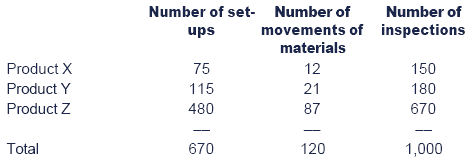
Required:
Calculate the cost per unit for each product using ABC principles.

Advantages and disadvantages of ABC
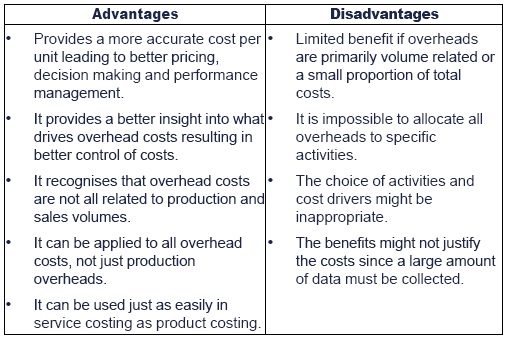
3.5.2 Activity based management (ABM)
 Activity based management (ABM) is the use of ABC information for management purposes to improve operational and strategic decisions.
Activity based management (ABM) is the use of ABC information for management purposes to improve operational and strategic decisions.
Uses
By identifying the underlying drivers of activities, ABM providesan understanding of the resource implications of various courses ofaction and therefore ensures that unfeasible courses of action are nottaken.
ABM can help middle managers to make decisions that benefit the whole organisation, not just their activities' bottom line.

 Use of ABM
Use of ABM
Companies use ABM to
- Re-price products and optimise new product design. Managers can more accurately analyse product profitability by combining activity-based cost data with price information. This can result in the re-pricing or elimination of unprofitable products. This information also is used to accurately estimate new product costs. By understanding cost drivers managers can design new products more efficiently.
- Reduce costs. ABC identifies the components of overhead costs and the drivers of cost variability. Managers can reduce costs by decreasing the cost of an activity or the number of activities per unit.
- Influence strategic and operational planning. Implications for action from an ABM study include target costing, performance measurement for continuous improvement, and resource allocation based on projected demand by product, customer, and facility. ABM can also assist a company in considering a new business opportunity or venture.


 Test your understanding 7
Test your understanding 7
Briefly discuss the potential risks associated with ABM.


 Illustration 1 - The application of ABM
Illustration 1 - The application of ABM
DHL
In the 1990s, DHL saw its margins decreasing and used ABM to reverse this trend.
- Falling margins were mainly due to changes in product, destination and customer mixes.
- DHL concluded that they did not have sufficient visibility of margins to enable better pricing policies (and had different policies in different countries) so implemented ABC.
- A greater understanding of margins allowed DHL to design and implement a new pricing structure that was adopted worldwide.

3.5.3 Activity-based budgeting (ABB)
Now that we understand the concepts of ABC and ABM, we can review the final approach to budgeting, ABB.
 Activity-based budgeting(ABB) uses the principles of ABC to estimate the firm's future demandfor resources and hence can help the firm to acquire these resourcesmore efficiently.
Activity-based budgeting(ABB) uses the principles of ABC to estimate the firm's future demandfor resources and hence can help the firm to acquire these resourcesmore efficiently.

 Illustration 2 – Steps in ABB
Illustration 2 – Steps in ABB
The operating divisions of Z plc have in the past always used atraditional (absorption costing) approach to analysing costs into theirfixed and variable components. A single measure of activity was usedwhich, for simplicity, was the number of units produced. The newmanagement does not accept that such a simplistic approach isappropriate for budgeting in the modern environment and has requestedthat the managers adopt an activity-based approach to their budgets inthe future.
Required
Explain how ABB would be implemented by the operating divisions of Z plc.
Solution
Step 1: Estimate the production and sales volumes of individual products or customers.
Step 2: Estimate the demand for organisational activities.
Step 3: Determine the resources that are required to perform organisational activities.
Step 4: Estimate for each resource the quantity that must be supplied to meet the demand.
Step 5: Take action to adjust the capacity of resources to match the projected supply.

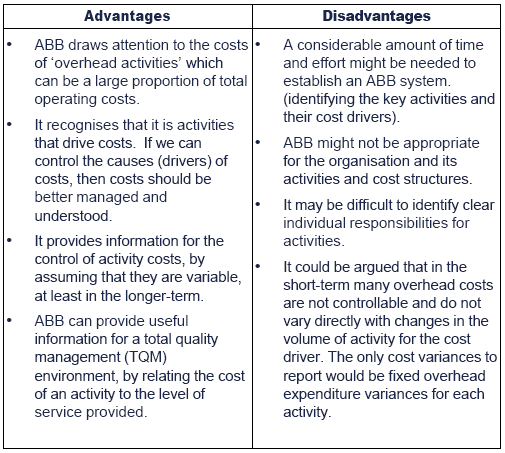

 ABB
ABB
A company has prepared an activity-based budget for its stores department. The budgeted costs are:
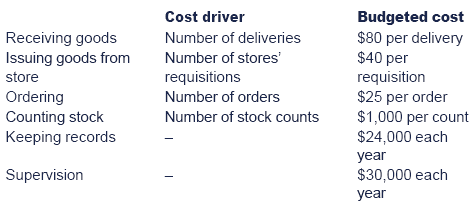
Actual results for April were:

Required:
Prepare a variance report for the month.
Solution:


Question focus: Now attempt question 5 from chapter 13. This question examines ABB and benchmarking (which was covered in chapter 1).
4 Beyond budgeting
4.1 Criticisms of traditional budgeting
Traditional budgets based on fixed annual periods:
- encourage rigid planning and a lack of flexibility. This may not be appropriate in a fast moving business environment.
- are time consuming.
- encourage managers and employees to meet only the lowest target rather than attempting to beat the target set (this is inconsistent with a TQM approach).
- encourage managers and employees to achieve the budget even if this results in undesirable action.
- encourage managers and employees to spend what is in the budget, even if it is not necessary, to guard against next year's budget.
- reinforce the barriers between departments rather than encourage knowledge sharing.
- are seen as a mechanism for top-down control by senior management but organisations should be empowering individuals on the front-line.
- ignore key drivers of shareholder value by focusing on short term financial performance.
- produced inadequate variance reports leaving the 'how' and 'what' unanswered.
4.2 What is beyond budgeting?
 Beyond budgetingis a leadership philosophy that relates to an alternative approach tobudgeting which should be used instead of traditional annual budgeting.
Beyond budgetingis a leadership philosophy that relates to an alternative approach tobudgeting which should be used instead of traditional annual budgeting.
Characteristics
- Rolling budgets, produced on a quarterly or monthly basis, are suggested as the main alternative to annual budgeting. These are flexible, do not rely on obsolete figures and should result in more timely allocation of resources.
- The rolling forecasts will embrace KPIs based on the balanced scorecard (balanced scorecards will be discussed in chapter 10) which is linked to organisation strategy. Managers' performance measures will be based on this.
- The budget may also incorporate benchmarking linking managers' targets to external benchmarks and not past performance.
- Focus efforts on managing future results and not explaining past performance.
- Allow operational managers to react to the environment.
- Encourage a culture of innovation.
Summary of the main differences between the traditional and the new beyond budgeting model as outlined by Jeremy Hope:
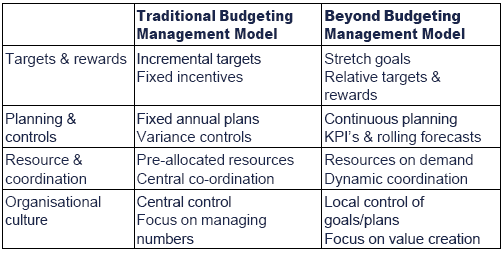
Suitability
- Industries where there is rapid change in the business environment. Flexible targets will be responsive to change.
- Organisations using management methods such as TQM. Continuous improvement will be key.
- Organisations undergoing radical change, e.g. using business process re-engineering. Budgets may be hard to achieve in such circumstances.
Question focus: Now attempt question 1 part (a) from chapter 13.

 Beyond budgeting
Beyond budgeting
An article in March 2005, Student Accountant outlined the following benefits of the 'beyond budgeting' model;
- It shifts the focus from beating other managers to beating the competition by creating a climate based on competitive success.
- It motivates individuals by giving clear responsibilities and challenges.
- It eliminates some behavioural issues by making rewards team-based.
- Authority is devolved to operational managers who are closer to the action and so can react quickly.
- Operational managers are empowered to deliver key ratios rather than keep to strict budget limits.
- It establishes customer-orientated teams.
- It creates information systems which provide fast and open information throughout the organisation.


 Public and private sector
Public and private sector
Beyond budgeting in the private sector
This entails devolved managerial responsibility where power and responsibility go hand in hand.
- The focus moves from beating other managers to beating the competition.
- It motivates people giving them challenges, responsibilities and clear guidelines.
- Rewards are team based.
- Performance responsibilities are given to operational management who are closer to the action.
- It empowers managers to remove resource constraints
- Creation of open information systems throughout the organisation.
Beyond budgeting in the public sector
The greater flexibility that lies at the heart of beyond budgetingmay prevent successful application of the model in the public sector.
Beyond budgeting would require a mindset which not only moves awayfrom control but also requires a reduction in internal politics whichhas been at the heart of the public sector for many years.
The managers within the public sector may have the desire forflexibility but are likely to remain constrained by the inability oftheir organisation to change.

5 Budgeting in not-for-profit organisations
5.1 Introduction
 Not-for-profit organisations,NFPOs, include organisations of many different forms, for exampleschools and universities, social clubs, sports clubs, sports governingbodies, hospitals, museum/library/arts organisations, governmentorganisations/local authorities and charities.
Not-for-profit organisations,NFPOs, include organisations of many different forms, for exampleschools and universities, social clubs, sports clubs, sports governingbodies, hospitals, museum/library/arts organisations, governmentorganisations/local authorities and charities.
5.2 Things to consider when preparing a budget in a NFPO
- No profit motive - but these organisations still need to control costs.
- Non-quantifiable benefits - many of the benefits arising from expenditure by these bodies are non-quantifiable (certainly not in monetary terms, e.g. social welfare). So how can measurable budgets be prepared which meet the organisation's objectives?
- No revenue generated - often revenue is not generated and there is a fixed budget for spending within which they have to keep. 'Value for money' is often quoted as an objective here but it does not get round the problem of measuring 'value'.
- Multiple stakeholders - give rise to multiple objectives so there is a need to prioritise/compromise (e.g. hospital – patients, staff, government, taxpayers, local community, society at large, contractors, management, donors/contributors, etc.).
- Objectives - may be difficult to define, may change as a result of the political process and may be achievable in different ways.

 Objectives
Objectives
A further consideration is that the distinction between objectivesand ways of achieving these is often misunderstood. For example, onepublic objective is 'to contain crime within reasonable limits'. Onemeans of achieving that objective is to have police officers patrollingthe streets on foot. In fact, police foot patrols are a very inefficientmethod of containing crime. The use of video surveillance cameras andpolice response units using fast cars is much more cost effective.

5.3 Public sector budgets
- Budgets tend to concentrate on planning for one year ahead.
- Incremental budgeting is traditionally used.
- Other budgeting approaches such as ZBB and planned programme budgeting systems (PPBS) have been used.
PPBS
- PPBS breaks work down into programmes designed towards achieving various objectives.
- Several departments may contribute towards a single programme.
- Budget targets may spread over more than one year.
- The means used to achieve programmes should be efficient and cost-effective.

 Efficiency
Efficiency
Efficiency revolves around making the maximum possible use of agiven set of resources. That is, it involves a straight comparison ofoutput and input.
Many UK local authorities in the 1970s were judged to be making aninefficient use of the resources available to them. They undertook mostof their activities (e.g. council house maintenance, road repairs,maintenance of parks and gardens, etc.) using large numbers of directcouncil employees. It was often found that the use of obsolete equipmentand inefficient working practices (strict job demarcation waswidespread) resulted in the operation involving excessive costs.
Financial management initiatives in the 1980s required localauthorities to put many of their activities 'out to tender'. Privatecontractors may submit bids in order to undertake programmes of work forthe local authorities. If the councils retain a direct worksdepartment, then that department has to bid in competition with privatecontractors for most available work.
The advent of executive agencies in national government is anotherexample of this approach. Government has devolved some of its functionsto agencies (e.g. the DVLA at Swansea) which are run on semi-commerciallines. The performance of these agencies is monitored using targetperformance indicators (e.g. the average time it takes to issue a newdriving licence or the average time it takes to respond to a policeenquiry concerning a vehicle).

6 Forecasting
6.1 Introduction
You may be asked to prepare a forecast in the exam. A number of forecasting methods were reviewed in paper F5 including:
- the hi-low method
- regression analysis
- time series analysis
- the learning curve model.
The learning curve model will be recapped below.
6.2 The learning curve effect
As workers become more familiar with the production of a newproduct, the average labour time (and average labour cost) per unit willdecline.
Wright's Law states that as output doubles, the average timeper unit falls to a fixed percentage (referred to as the learning rate)of the previous average time.
The learning curve effect can be calculated using the following formula:
y = axb
where:
y = the average time (or average cost) per unit/batch
a = time (or cost) for the first unit/batch
x = output in units/batches
b = log r/log 2 (r = rate of learning, expressed as a decimal).
The formula can be used to forecast the cost of labour but wouldnormally be examined as part of a bigger forecasting question such asthe one below.

 Test your understanding 8
Test your understanding 8
BFG Ltd is investigating the financial viability of a new product,the S-pro. The S-pro is a short-life product for which a market has beenidentified at an agreed design specification. The product will onlyhave a life of 12 months.
The following estimated information is available in respect of the S-pro.:
(1) Sales should be 120,000 in the year inbatches of 100 units. An average selling price of $1,050 per batch of100 units is expected.
(2) An 80% learning curve will apply for thefirst 700 batches after which a steady state production time will apply,with the labour time per batch after the first 700 batches being equalto the time of the 700th batch. The labour cost of the first batch wasmeasured at $2,500. This was for 500 hours at $5 per hour.
(3) Variable overhead is estimated at $2 per labour hour.
(4) Direct material will be $500 per batch forthe S-pro for the first 200 batches produced. The second 200 batcheswill cost 90% of the cost per batch of the first 200 batches. Allbatches from then on will cost 90% of the batch cost for each of thesecond 200 batches.
(5) S-pro will require additional space to be rented. These directly attributable fixed costs will be $15,000 per month.
A target net cash flow of $130,000 is required in order for the project to be acceptable.
Note: At the learning curve rate of 80% the learning factor (b) is equal to – 0.3219.
Required:
Prepare detailed calculations to show whether S-pro will provide the target net cash flow.

The learning curve and the steady state
The learning effect will only apply for a certain range ofproduction. Once the steady state is reached the direct labour hourswill not reduce any further.

 Limitations of the learning curve model
Limitations of the learning curve model
The learning curve model on applies if:
- there are no breaks in production: a break in production may result in the learning effect being lost.
- the product is new: the introduction of a new product makes it more probable that there will be a learning effect.
- the product is complex: the more complex the product, the more probable that the learning effect will be significant and the longer it will take for the learning effect to reach the steady state.
- the process is repetitive: if the process is not repetitive, a learning effect will not be enjoyed.
- the process is labour intensive: the learning effect will not apply if machines limit the speed of labour.

Question focus: Now attempt question 3 from chapter 13.
Chapter summary
Test your understanding answers

 Test your understanding 1
Test your understanding 1
(a)At first sight, the costs are higher meaningthe company has done worse, from a cost control angle, but then theactivity level is 20% higher than planned. If all costs are variable, wewould expect costs to rise in line with activity, making expected costs20,000 x 1.2 = $24,000. In this case the company has done better thanexpected.
(b)The fixed costs of $10,000 will NOT rise inline with activity levels whereas the variable costs of $10,000 willincrease in line with activity levels. Therefore, the expected cost ofthe actual level of activity will be ($10,000 x 1.2) + $10,000 =$22,000. The actual cost is $23,000 so the company has spent more thanexpected.


 Test your understanding 2
Test your understanding 2
(W1) Actual patient numbers were 18.75% above budget, i.e.((23,750 – 20,000) ÷ 20,000) × 100 = 18.75%. Therefore, budgetedvariable costs should be increased by 18.75%.
Cost statements for the year ended 31 December 20X0
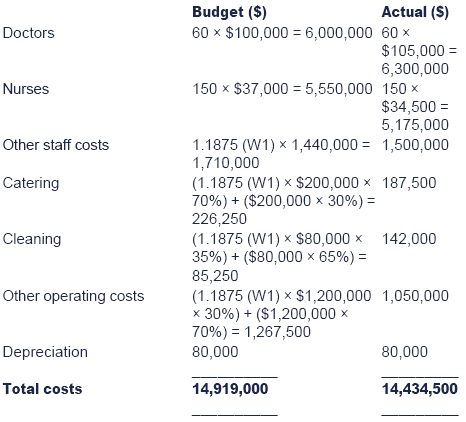


 Test your understanding 3
Test your understanding 3
NWEC Budgeted Profit and Loss Statement for year to 30 November 20X4

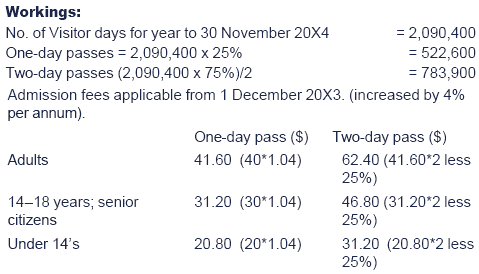



 Test your understanding 4
Test your understanding 4
The managers/researchers responsible for each project should decidewhich projects they wish to undertake in the forthcoming period. Theseprojects will be a mixture of continued projects and new projects.
For the projects which have already been started and which themanagers want to continue in the next period, we should ignore any cashflows already incurred (they are sunk costs), and we should look only atfuture costs and benefits. Similarly, for the new projects we shouldonly look at the future costs and benefits.
Different ways of achieving the same research goals should also beinvestigated and the projects should go ahead only if the benefitexceeds the cost.
Once all the potential projects have been evaluated, if there areinsufficient funds to undertake all the worthwhile projects, then thefunds should be allocated to the best projects on the basis of acost-benefit analysis.
ZBB is usually of a highly-subjective nature. (The costs are oftenreasonably certain, but usually a lot of uncertainty is attached to theestimated benefits.) This will be even more true of a research divisionwhere the researchers may have their own pet projects which they areunable to view in an objective light.


 Test your understanding 5
Test your understanding 5
The revised budget should incorporate 3% growth starting from the actual sales figure of Q1.

Workings
- Q2: Budget = $123,450 x 103%
- Q3: Budget = $127,154 x 103%
- Q4: Budget = $130,969 x 103%


 Test your understanding 6
Test your understanding 6
(W1) Overheads
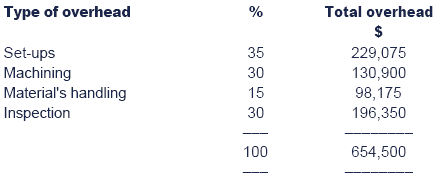

Step 3: Calculate an OAR for each activity
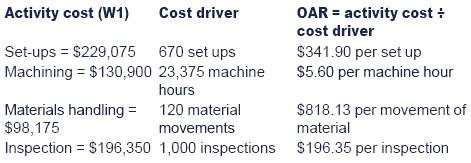
Step 4: Absorb activity costs into products

Step 5: Calculate the full production cost per unit

ABC has resulted in a significant change in the full productioncost per unit. The cost of products X and Y have approximately doubledwhere as the cost of product Z has decreased by approximately 13%.


 Test your understanding 7
Test your understanding 7
Some activities will have an implicit value which is notnecessarily reflected in the financial value of the product. Forexample:
- A pleasant workplace can help attract/retain the best staff. A risk of operational ABM is that this activity is eliminated.
- A low value customer may open up new leads in the market. A risk of strategic ABM is that this customer is eliminated.


 Test your understanding 8
Test your understanding 8
BFG Ltd Net cash flow calculation
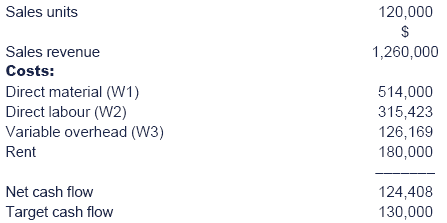
The target cash flow will not be achieved.
Workings:
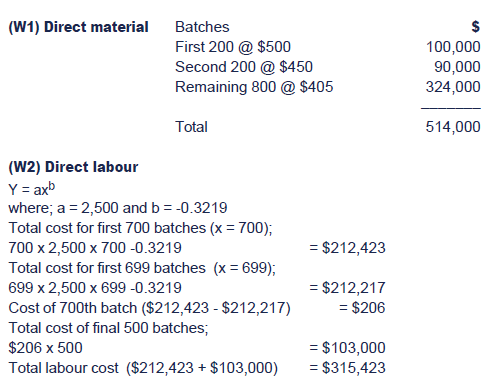
(W3) Variable overhead
Variable overhead is $2 per labour hour, or 40% of the direct labour cost.

|
Created at 5/24/2012 4:27 PM by System Account
(GMT) Greenwich Mean Time : Dublin, Edinburgh, Lisbon, London
|
Last modified at 5/25/2012 12:55 PM by System Account
(GMT) Greenwich Mean Time : Dublin, Edinburgh, Lisbon, London
|
|
|
|
 |
Rating
:
|
 Ratings & Comments
(Click the stars to rate the page) Ratings & Comments
(Click the stars to rate the page)
|
 |
Tags:
|
|
|
|
|